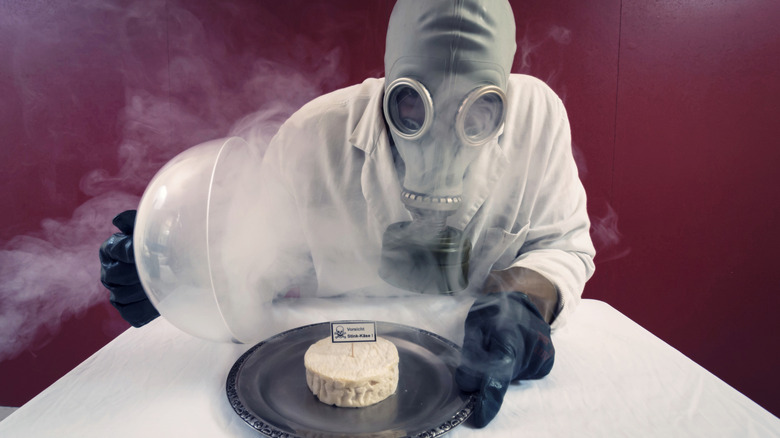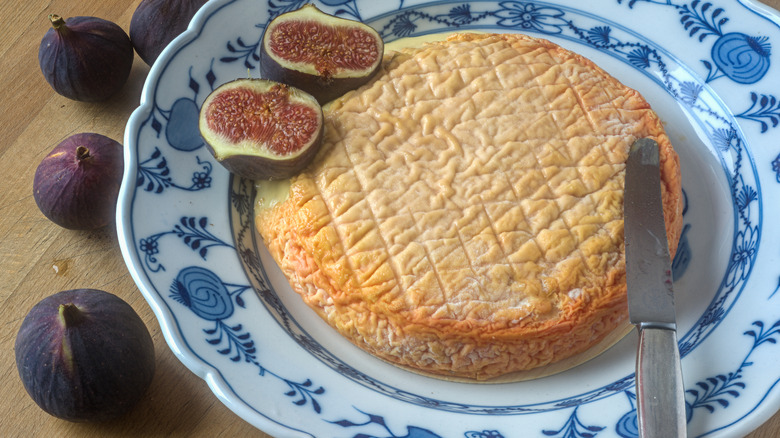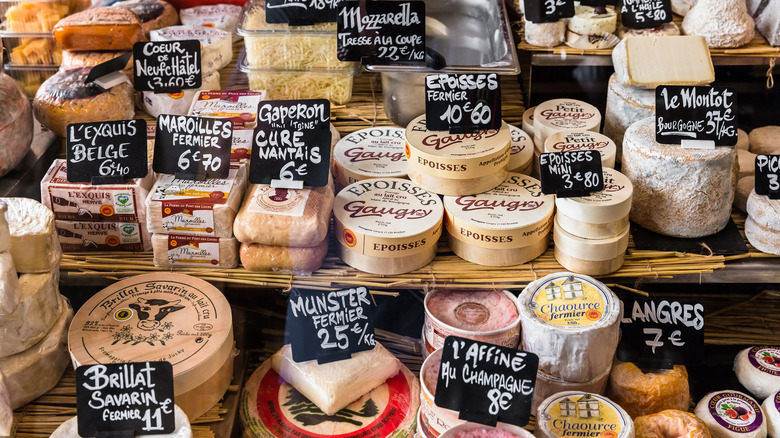The Pungent French Cheese You Shouldn't Judge On Smell Alone
At first sniff, the waft of the specialty cheese department is enough to knock even the most avid cheese fans off their feet. While the scent can impact the eating experience, it doesn't necessarily match the taste. We can rely on our senses to warn us of many things, but not everything. Contrary to many assumptions (and noses), the funky aroma doesn't always linger past the first bite. When it comes to cheese's aroma, the potency lies in the process. Between the starter culture and aging process, cheese can take on a certain funk that powers the taste and can even impact the mouthfeel.
French cheese, in particular, tends to have a funky aroma, with one of its leading offenders being Époisses de Bourgogne. It is described as a smear-ripened cheese; the creamy creation has a distinctive orange rind with a melt-in-your-mouth texture. While its home is Burgundy, Époisses has made quite the name for itself all around the globe. It's traditionally made with raw cow's milk, but due to varying regulations, the U.S. only offers a pasteurized version with less bite. For the real deal, head to the small village of Époisses in eastern France. It certainly has that je ne c'est quoi and surprises every taste bud.
Époisses' storied past
Époisses hails from France's Bourgogne region and has become one of the world's most recognized cheeses for both its powerful aroma and flavor. With its historic roots, the cheese's origin story has become a bit waffled, but historians confirm it originated at some point during the Renaissance period. Mons Cheesemongers presents a picture from the 14th century as dairy farming was becoming more common among the monastic community. Époisses was allegedly first crafted by Cistercian monks habituating in Époisses. With their limited but dependable resources, they began farming dairy and managed to develop the complex Époisses. The cheese achieved great local recognition, including from Jean Anthelme Brillat-Savarin who even termed it the "king of all cheeses" (via Wall Street Journal).
The recipe was passed between friends for centuries until ultimately being adopted by hundreds of farms. That was until the end of World War II when cheese production in the small Burgundy town reached an all-time low and most dairy farmers couldn't make ends meet. Despite its exclusion from the public eye for generations, the decadent recipe lived on and re-emerged into the cheese scene in the 1950s. There were only a few farms producing Époisses at the time when Robert and Simone Berthaut set up shop in 1956. They went from basement cheesemongers to a fixture of the small French community. Visitors would flock to their fromagerie and it wasn't long before their fame spread worldwide.
The intricate cheese-making process
Époisses is a washed rind raw cow's milk cheese that's so gooey it requires a sturdy wooden box to keep it intact. The complexity of the cheese can be attributed to a handful of production quirks. Washed rind cheese traditionally delivers a unique taste, but Époisses takes it a step further by incorporating acidity in the cheesemaking process. Referred to as "caillé lactique" (which loosely translates to acid curd), this method involves coagulating the cream with acid and heat rather than rennet. This technique delivers a soft, creamy cheese with a delicate texture that can be difficult to handle. Given the shapeshifting nature of the oozy cheese, washing the rind is even more impressive. The washing process is meticulous and can take a few weeks.
As if the bold scent and flavor weren't enough to set this cheese apart from others, it keeps getting more special. The ripe, orange-highlighted rind is washed with a regional brandy, Marc de Bourgogne. Brandy serves two functions: Flavor and firming. The alcohol helps to harden the rind, protecting the creamy cheese, while enhancing its savor. To be legally dubbed Époisses, the cheese must be aged for at least a month. From there, vendors can carry on with their maturation process as they wish and see just how funky it can get.
A smell that fills the room
For those that are just beginning to explore the world of gourmet cheeses, Époisses might be an intense place to start. With an overwhelming scent that almost stings the nose, many are hesitant to give it a chance, and with good reason. Even in its own country, Époisses was banned on public transit so commuters didn't need to stock up on nose plugs. The smell is truly reminiscent of rank feet, but if you can stomach it, it's well worth it.
We can thank the unique washing and aging process for the pungent fragrance. As offensive as it is, it's all part of the process. The brandy wash attracts a bacteria called Brevibacterium, which smells awful while supporting the fermentation process. In order to get that perfect oozy center, Époisses has to mature, and a longer aging process means more time for bacteria to work their magic and emit that stinky foot odor.
Alternatively, if stinky cheese is your thing, then this is the holy grail of cheeses. Chemist Robert Wolke wrote in The Washington Post in 2006, "The protein breaks down into amino acids and eventually to ammonia, which has a pungent, unpleasant smell and is a clear signal of an overripe cheese, although some people enjoy a touch of ammonia in their Camembert."
The taste doesn't match the aroma
Before plugging your nose and reaching for a cheddar, give Époisses a chance. As potent as the odor is, the taste is surprisingly delicate. The rich, smearable cheese echoes an earthy flavor with notes of umami and garlic that linger on the tongue. It somehow tickles every sense, bursting with salt, spice, and sweetness. Before it reaches full maturity, Époisses can still be sliced, but it only gets creamier as it continues to age until it can hardly be contained within its sticky, orange rind.
Part of its complex flavor can be attributed to that notable rind, which is washed with a bit of water and Marc de Bourgogne. Marc de Bourgogne is known in France as an eau-de-vie, a.k.a "water of life" (per The Art of Eating), and boasts a delicate, fruity flavor. Derived from every part of the grape — skin, seeds, pulp — the spirit produces a distinct taste that lends well to the funky cheese.
Preparing and pairing Epoisses
Given its powerful flavor profile, Époisses is really more of a snacking cheese. All-star cheesemonger Patrick Ambrosio recommended to Taste of France accompanying Époisses with a thick slice of baguette or raisin-nut bread, while the Murray's Cheese crew would opt for the French sausage, Saucisson Sec and mini toasts to round out the snack.
Considering Époisses shares the same home as famed red Burgundy wines, it's only fitting that it pairs so perfectly with a nice Pinot Noir. Typically medium-bodied with a fruity finish, a regional Pinot Noir complements the funky layers of Époisses with its sharp acidity. Sommelier Vincent Bertheau advocates (via Wine Enthusiast) for northern Burgundy and would suggest opening a Côte de Nuits red Burgundy to sip alongside the spoon-able cheese. As La Truffière's in-house expert, Bertheau's insights come in high praise. With the complexities of this French cheese, it can easily overpower other flavors. For this reason, some may reach for a bolder red. Edward Behr of The Art of Eating goes the other way and favors a white Burgundy. Regardless of how it's served, Époisses will undoubtedly be the star of the show.





